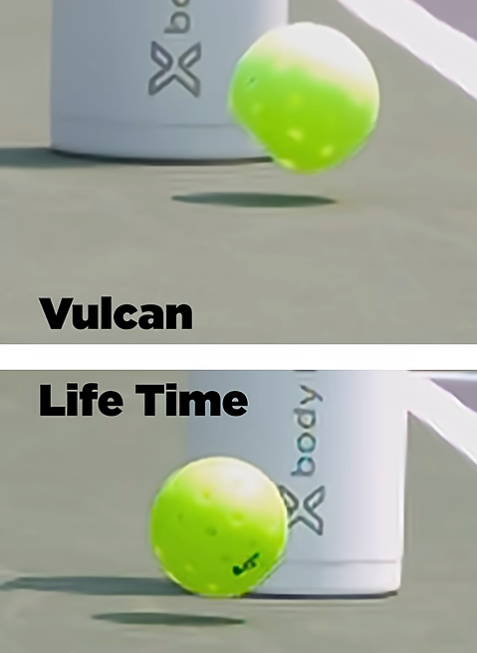
TL;DR
The PPA has switched from the Vulcan ball to the Lifetime ball. The Vulcan struggled with inconsistent bounce and short lifespan, while the Lifetime offers better durability, consistent bounce, and strong pro approval. It does lose some pop quickly, dropping ~1.7 mph in rebound speed after 300 hits, but then plays steady for 30–40 games, landing between the Selkirk S1 and Vulcan in pace. For most players, the trade-off of less early liveliness for long-term consistency makes it the more reliable choice.
PPA Makes the Switch: The Lifetime Ball is the New Ball of the PPA
The Professional Pickleball Association (PPA) has officially announced a major change, the Vulcan ball is out, and the Life Time Ball is in for all tournaments moving forward.
At the professional level, every detail matters, and the ball is no exception. Bounce, durability, and speed all shape how rallies play out and how fans experience the match. So what are the main differences?
Where the Vulcan Fell Short
The Vulcan ball had its supporters, but overall player feedback, from casual players to PPA pros, leaned negative.
Inconsistent Bounce – Some rallies flowed well, but too often the ball would skid or die unpredictably, throwing off timing.
Durability Concerns – Cracks, warping, and soft spots showed up sooner than expected, especially under the demands of tournament-level play.
In short, while the Vulcan worked for recreational use, it simply didn’t inspire confidence from players at the pro-level.
Why the Life Time Ball Stands Out
The Life Time Ball already had a solid reputation with competitive players, and its performance in Life Time PPA events only strengthened that.
Pros:
-
Consistent Bounce – Every rally feels more controlled and reliable.
-
Durability – Handles heavy play without cracking or deforming.
-
Player Approval – Top players have publicly backed it, which carries weight.
-
Enhanced Spectator Appeal – The slightly higher bounce promotes faster off-the-bounce attacks, making rallies more exciting to watch.
Cons:
-
Visibility – A few players have noted that the color can be harder to track under certain lighting conditions. (This color may stay, as dyes make the ball less durable)
Putting Durability to the Test
Chris and Aizec Olson at Pickleball Studio recently put the Life Time ball head-to-head with other popular options — Vulcan, Diadem, Franklin, Selkirk, and Dura. Each ball endured a series of heavy smashes.
Most of the balls deformed and stayed that way longer than players would like. The Lifetime, however, snapped back into shape almost instantly. That quick recovery not only preserves its bounce and pace but also means fewer interruptions in play due to ball inconsistencies.

I was impressed by how well the Life Time held its shape after repeated slams. This trait directly reduces unpredictable bounces and highlights durability as a major advantage. In fact, many accounts suggest the Lifetime lasts two to three times longer than other balls, making it the current leader in the durability category.
Life Time Break-in Period
The Life Time Ball starts off very lively, with a springy bounce and extra pace. But within the first few games, that pop fades. In testing (data from Johnkew), the ball lost 1.69 mph of rebound speed after 300 hits at 50 mph, dropping from 13.08 mph to 11.39 mph. While that sounds small, on court it’s a noticeable change.

Once broken in, though, the ball levels out and stays steady for 30–40 games with consistent bounce and excellent shape retention. Unlike many brands, it doesn’t need to be replaced often.
In terms of speed, the Life Time Ball settles in between the Selkirk S1 and the Vulcan. You give up some early pop, but the payoff is a ball that feels reliable and balanced over time. For players who prefer predictability and durability over raw liveliness, it’s a smart trade‑off.
What the Switch Means for Players
For Pros: Expect cleaner, faster rallies with fewer unpredictable bounces.
For Fans: More engaging matches, with more speed-ups, faster hands battle, and overall more entertaining play.
For Recreational Players: The Lifetime offers professional-level performance while holding up for more games than the competitors.
Final Thoughts
The PPA’s decision to adopt the Lifetime ball is more than just a gear swap; it’s a shift toward consistency, durability, and elevated match quality. While the ball may lose some of its initial spring after a short break-in period, what remains is a steady performer that retains its shape and delivers reliable bounce far longer than most competitors.
Personally, I think this is a smart trade-off. A ball that plays consistently for 30–40 games is far more valuable than one that feels fast for a few rallies but quickly cracks or turns egg-shaped. For me, the Lifetime sits in a sweet spot between the Selkirk S1 and the Vulcan, lively enough to keep rallies fun, but controlled enough to avoid chaotic, unpredictable play.
At the end of the day, a ball that blends durability with consistency is exactly what the sport needs as it grows. The Lifetime may not be the best for everyone, but it has quickly proven to be the most dependable in competitive pickleball.
